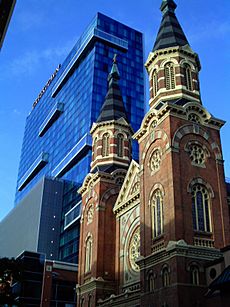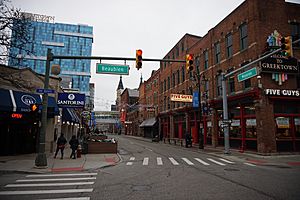Greektown, Detroit facts for kids
Quick facts for kids |
|
|
Greektown Historic District
|
|

Greektown at night
|
|
| Location | Detroit, Michigan, U.S. |
|---|---|
| Architect | Multiple |
| Architectural style | Late Victorian, Renaissance, Romanesque |
| NRHP reference No. | 82002902 |
| Added to NRHP | May 06, 1982 |
Greektown is a lively and historic area in Detroit, Michigan. It's a popular spot for food and fun, located just northeast of downtown. You can find it on Monroe Avenue, between Brush and St. Antoine streets.
This district is easy to reach using the Detroit People Mover, which has a station right there. Greektown is also close to famous Detroit landmarks. These include the Renaissance Center, Comerica Park, and Ford Field.
The area got its name from the many Greek immigrants who settled here in the early 1900s. Today, you can still find many Greek-themed restaurants. Important buildings in Greektown include St. Mary Roman Catholic Church and Second Baptist Church. The Athenium Suite Hotel and the modern Greektown Casino-Hotel are also within its borders. Greektown became a protected historic district in 1982. The Greek community often holds a parade here in March.
History of Greektown

The area we now call Greektown was first settled in the 1830s. German immigrants moved here and built homes. It was mostly a neighborhood where people lived.
In the early 1900s, many German families started moving to newer areas. As they left, a new group of people arrived: Greek immigrants. Theodore Gerasimos was the first Greek immigrant known to live in Detroit. These new Greek arrivals soon opened their own shops and businesses.
By the 1920s, the area was changing. More businesses were built, and many Greek residents also started moving to newer homes. But the Greek restaurants, stores, and coffeehouses they had created stayed. For the next 30 years, many different immigrants lived in the few remaining homes. In the 1960s, new city buildings and parking lots were built in the neighborhood.
Saving the Historic District
Detroit's Greek leaders realized their special neighborhood was at risk. They worked together with the Mayor's office to save it. They improved the streets and buildings. More streetlights were also added to make the area brighter.
In 1966, the neighborhood held a Greek festival. It was planned to happen at the same time as the Fourth of July celebrations. The festival was a big success. It continued for many years until it became too popular and too many people attended. By then, Greektown was a well-known part of Detroit. The Greektown Historic District was officially listed as a historic place in 1982.
Greektown Today
Greektown continues to change. As of 2012, only three full Greek restaurants remained. However, the neighborhood is still a very popular place for food and fun. It has many restaurants that serve real Greek food. It is also home to one of Detroit's three casinos, Greektown Casino.
Some buildings on Monroe Street have designs inspired by ancient Greece. You can see themes related to the mythical Pegasus. There are also designs like the Parthenon and other ancient Greek buildings. Greek music is played on Monroe Street all day long. Some well-known restaurants include The New Parthenon, The Golden Fleece, and Pegasus Taverna. The Detroit People Mover has a station right at the Greektown Casino.
See also
 In Spanish: Greektown (Detroit) para niños
In Spanish: Greektown (Detroit) para niños


